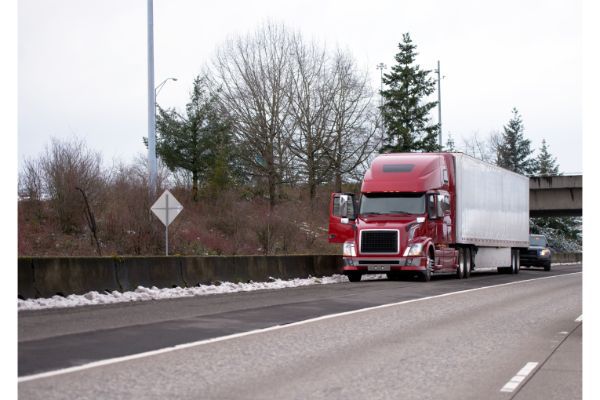For drivers traveling through CA, there are some things you should be aware of to save trouble at roadside inspections. First, there is a CHP roadside inspection station or Commercial Vehicle Enforcement Facility on Route 80 in the Donner Pass just west of the Nevada border. Many truckers call these weigh stations, the “chicken coop.”
Truckers heading to the San Francisco Bay area and the Oakland port often travel this route. All commercial motor vehicles must stop when it is open — some question what is a commercial vehicle and does weight play a role in who must stop.
Which Vehicles Must Stop at Roadside Inspections?
Although most think that only trucks and buses must stop, that is not true. A U-Haul or Ryder truck are commercial vehicles that must stop. This rule includes rental vehicles and vehicles used to transport passengers. Other trucks, such as pickups that meet the following benchmarks must stop or face a misdemeanor:
- “A gross vehicle weight rating (GVWR) of 11,500 pounds or more”
- When the unladen weight is of 8,001 pounds or higher
- Any open-box type of vehicle, nine feet or more
- Trucks with a flat-bed or utility bed
A good rule of thumb is if you are unsure, stop. It could save you a lot of trouble.
Mandatory Documents to Show at a Roadside Inspection
Most veteran truckers carry a folder or binder with the truck’s documents in it. You must show the following documents at the weigh station when asked, so it will go quicker if you have these items ready for inspection:
- Commercial Driver’s License and all endorsements
- Truck registration documents
- Proof of Insurance
- Special permits for oversized loads
- Shipping papers and bills of lading for hazardous material
- Fuel tax receipts and permits
- Last seven days of logs
- Any documents requested by the inspector
Mexican and Canadian vehicles must carry “financial responsibility” documents in each vehicle used in the USA. California-based vehicles must have their CA number, Motor Carrier Permit, and USDOT number. While out of state vehicles must have the USDOT number only.
Items Typically Checked at Roadside Inspections

Most roadside inspections only require the vehicle to drive across the scales and if you are within weight and your documents are all there, you can usually proceed. However, when your carrier’s SMS percentile is 75-100, you will very likely get inspected. The inspector could do anything from a cursory walk-around to full inspection. Arguing with an inspector or not doing as they ask will usually result in a more thorough examination.
The inspectors could inspect for:
- Brakes and adjustments
- Fluid leaks
- Emissions
- E-logs
- Tires, lights, and reflectors
- Cargo tie-downs
The better prepared you are for a roadside inspection, the quicker it will go, and you will be back out on the road.
California Specific Rules
In CA, it is illegal to idle your truck for more than five minutes, even when you are in the sleeper berth. Although it’s controversial and there have been several rulings and appeals about California’s mandatory breaks, the rule is you are allowed one 30-minute break every five hours and a ten-minute break every four hours.
The problem with these laws is enforceability. Do not expect to get ticketed for not meeting these standards, but don’t expect to get paid for them either. You must follow the FMCSR rule of taking a mandatory 30-minute break before the eight-hour mark of coming on duty. Some of these Hours of Service (HOS) rules are currently under review, but the proposed regulations are not enforceable yet.
Also, CA has a smog testing rule that applies to a vehicle manufactured after 1997. Unless your truck is older than that, you should comply with those laws and submit to testing.
The best policy is to ensure your truck complies with the strictest standard to avoid issues. When you do have an issue, consult a traffic attorney.
What Is the Surface Transportation Assistance Act (STAA)?
The STAA is much like the whistleblower law. When you report a malfunction or mechanical problem with the truck you must drive, and the trucking firm refuses to fix the problem, you cannot be retaliated against for reporting safety issues.
Say the brakes are out of adjustment and you report it on your daily vehicle inspection report (DVIR) and the mechanic signs off saying it is safe. You cannot be fired or disciplined for informing fleet management. Nor can they retaliate if you raise the issue to CHP, Caltrans, or any authority. The carrier cannot make you drive a vehicle you think is unsafe.
What to Do About a Roadside Inspection Violation
If you are issued a violation, there is usually no point in arguing, it could just lead to further delays. Sign the ticket and consult a traffic ticket attorney.
Who Should I Call to Handle My Truckee Roadside Inspection Violation?
When you get ticketed for a roadside inspection violation, call Bigger & Harman at (661) 349-9300. Se habla Español (661) 349-9755.
We handle traffic tickets and DMV Hearings for CDL holders across California. We only handle traffic law, so we are familiar with the procedure in traffic court. We use a flat fee, so you always know how much you will pay to resolve your ticket.
Send us an email, attorney@biggerharmanlaw.com.
References:
The 2019 CA Commercial Driver Handbook .pdf
